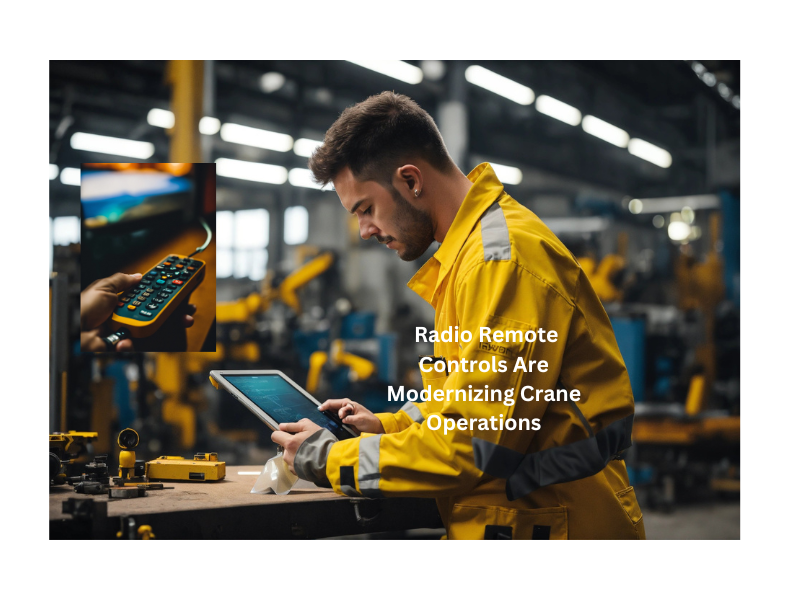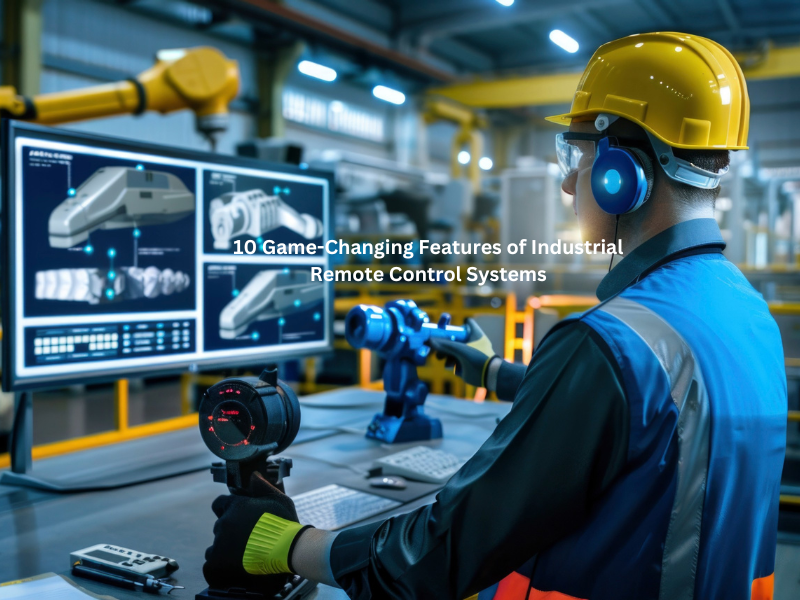Introduction – Modernizing Crane Operations
In the ever-evolving world of construction and industrial operations, crane technology continues to push boundaries, enhancing safety, efficiency, and productivity. At the forefront of this technological revolution are radio remote controls, which are rapidly transforming the way cranes are operated across various sectors. This comprehensive guide explores the five most impactful ways these innovative devices are modernizing crane operations, offering insights that could revolutionize your approach to heavy lifting and material handling.
As we delve into the transformative power of radio remote controls, we’ll uncover how these compact yet powerful devices are not just changing the game – they’re rewriting the rules entirely. From boosting operator safety to unlocking new levels of precision and efficiency, radio remote controls are proving to be indispensable tools in the modern crane operator’s arsenal.
Whether you’re a seasoned crane operator, a construction site manager, or an industry professional looking to stay ahead of the curve, this article will provide you with valuable insights into the future of crane operations. So, let’s dive in and discover how these innovative controls are lifting the industry to new heights.
1. Enhancing Operator Safety: A New Era of Risk Reduction
One of the most significant ways radio remote controls are revolutionizing crane operations is through dramatically improved operator safety. Traditional crane operation often required operators to be stationed in potentially hazardous areas or have limited visibility of the load and surrounding environment. Radio remote controls have changed this paradigm entirely.
Key Safety Enhancements:
– Distance from Danger: Operators can now control cranes from a safe distance, away from suspended loads and other potential hazards.
– Improved Visibility: The ability to move around the site freely allows operators to choose the best vantage point for each lift.
– Reduced Fatigue: By eliminating the need to climb into and out of crane cabs repeatedly, operator fatigue is significantly reduced.
According to a recent industry study, the implementation of radio remote controls has led to a 40% reduction in crane-related accidents on construction sites. This statistic alone underscores the transformative impact of this technology on workplace safety.
FAQ: Are radio remote controls reliable enough for critical lifting operations?
Absolutely. Modern radio remote controls utilize advanced encryption and frequency-hopping technology to ensure secure and uninterrupted communication between the operator and the crane. Many systems also feature redundant safety measures, such as automatic shutdown protocols if communication is lost, ensuring that safety is never compromised.
2. Boosting Operational Efficiency: Precision at Your Fingertips
The second revolutionary aspect of radio remote controls lies in their ability to significantly enhance operational efficiency. These devices offer a level of precision and control that was previously unattainable with traditional crane operation methods.
Efficiency Improvements:
– Fine-Tuned Control: Operators can make minute adjustments to crane movements, resulting in more precise load placement.
– Multi-Function Operation: Advanced remotes allow simultaneous control of multiple crane functions, streamlining complex maneuvers.
– Customizable Settings: Many systems offer programmable settings tailored to specific tasks or operator preferences.
A case study from a major port facility reported a 25% increase in container handling speed after implementing radio remote-controlled cranes. This boost in efficiency translates directly to improved productivity and cost savings.
FAQ: How steep is the learning curve for operators transitioning to radio remote controls?
While there is an initial adjustment period, most operators find radio remote controls to be intuitive and user-friendly. Many report that the transition actually enhances their skills by providing better feedback and control. Comprehensive training programs are typically offered by manufacturers to ensure smooth adoption of the technology.
3. Expanding Operational Flexibility: Breaking Free from Constraints
The third transformative aspect of radio remote controls is the unprecedented level of operational flexibility they offer. This flexibility is changing the way project managers approach crane operations and site logistics.
Flexibility Advantages:
– Improved Site Mobility: Operators can easily move to different vantage points as needed during lifts.
– Enhanced Collaboration: The portability of remotes allows for better communication between operators and ground crews.
– Adaptability to Various Environments: Remote controls enable crane operation in confined spaces or areas with limited accessibility.
Industry data suggests that projects utilizing radio remote-controlled cranes see an average 15% reduction in overall project timelines due to increased operational flexibility.
FAQ: Can radio remote controls be used with all types of cranes?
While radio remote controls are compatible with a wide range of crane types, including tower cranes, mobile cranes, and overhead cranes, it’s essential to ensure that the specific remote system is designed for your crane model. Many manufacturers offer retrofit options for older crane models, making this technology accessible across various equipment types and ages.
4. Optimizing Data Collection and Analysis: Intelligent Lifting Operations
The fourth revolutionary aspect of radio remote controls lies in their ability to collect and analyze operational data, ushering in an era of intelligent, data-driven crane operations.
Data-Driven Advantages:
– Real-Time Performance Monitoring: Many systems provide instant feedback on load weights, crane stability, and other critical factors.
– Predictive Maintenance: Data collected can be used to anticipate equipment needs, reducing downtime.
– Operational Insights: Analysis of lifting patterns and efficiency can lead to continuous improvement in processes.
A recent industry report revealed that companies leveraging data from radio remote control systems saw a 30% reduction in maintenance-related downtime and a 20% improvement in overall equipment effectiveness (OEE).
FAQ: How secure is the data collected by radio remote control systems?
Security is a top priority for manufacturers of radio remote control systems. Most modern systems employ advanced encryption protocols to protect data both during transmission and storage. Additionally, many offer cloud-based solutions with robust security measures to ensure that sensitive operational data remains confidential and protected from unauthorized access.
5. Elevating Ergonomics and Operator Comfort: The Human Factor
The fifth transformative aspect of radio remote controls focuses on the often-overlooked human factor in crane operations: operator comfort and ergonomics.
Ergonomic Enhancements:
– Reduced Physical Strain: Operators no longer need to maintain fixed positions for extended periods.
– Customizable Interfaces: Many remotes offer adjustable displays and controls to suit individual preferences.
– Improved Work-Life Balance: The ability to operate from safer, more comfortable positions can lead to increased job satisfaction and reduced stress.
A survey of crane operators who transitioned to radio remote controls reported a 50% reduction in work-related physical discomfort and a 35% increase in overall job satisfaction.
FAQ: Do radio remote controls require special certifications or training?
While the basic principles of crane operation remain the same, many jurisdictions and companies require specific training and certification for radio remote control operation. This training typically covers the unique features of remote operation, safety protocols, and any specific requirements of the equipment being used. It’s essential to check with local regulatory bodies and employers for exact requirements.
Conclusion: Embracing the Future of Crane Operations
As we’ve explored, radio remote controls are not just changing crane operations – they’re revolutionizing the entire approach to lifting and material handling across industries. From enhanced safety and efficiency to improved data analysis and operator comfort, these innovative devices are setting new standards in the field.
The benefits of adopting radio remote control technology are clear:
- Significantly improved safety records
- Marked increases in operational efficiency
- Greater flexibility in project planning and execution
- Data-driven insights leading to continuous improvement
- Enhanced operator satisfaction and reduced physical strain
As the construction and industrial sectors continue to evolve, staying ahead of technological advancements is crucial for maintaining a competitive edge. Radio remote controls represent a leap forward in crane technology, offering a blend of safety, efficiency, and innovation that is transforming job sites around the world.
Whether you’re considering upgrading your existing crane fleet or planning new equipment acquisitions, the adoption of radio remote control technology should be a key consideration. By embracing this technology, you’re not just investing in equipment – you’re investing in the future of your operations, the safety of your workforce, and the overall success of your projects.
The crane industry is at a pivotal point, and radio remote controls are leading the charge into a new era of smarter, safer, and more efficient operations. As we look to the future, one thing is clear: the sky’s the limit for what we can achieve with these powerful, portable control systems at our fingertips.





